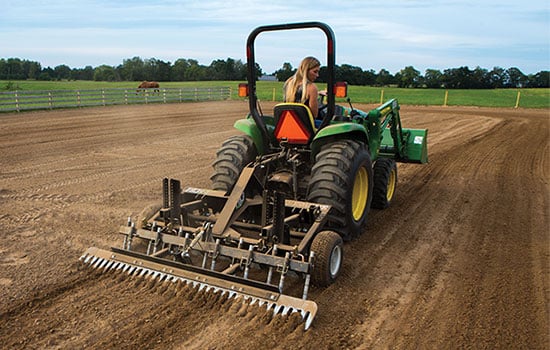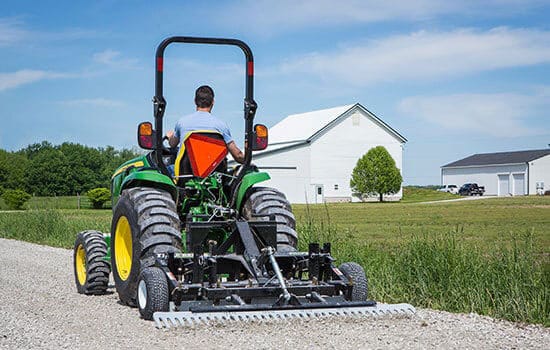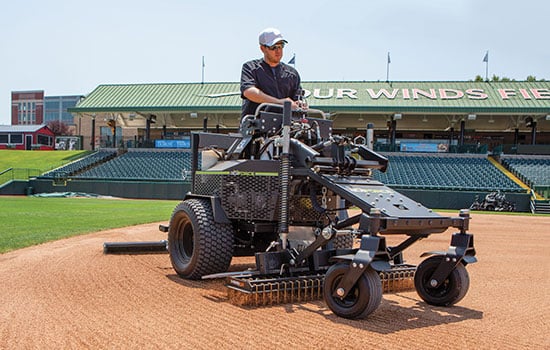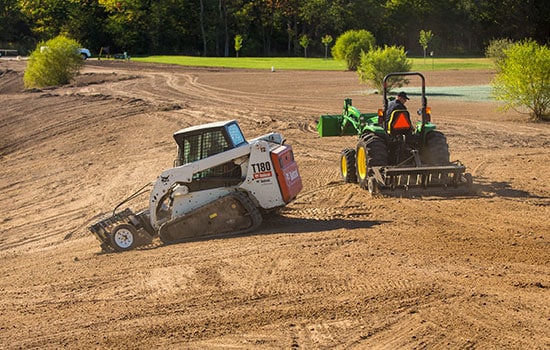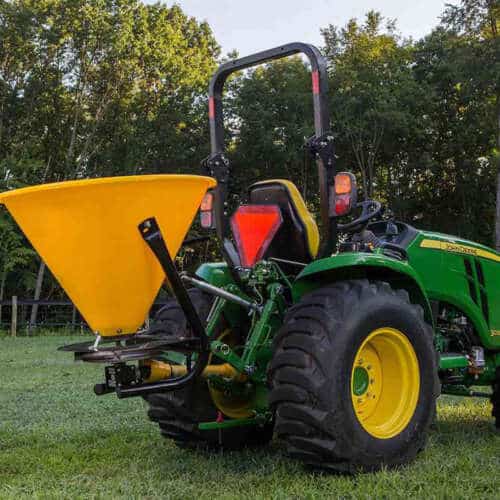Food Plotting Basics: Prepping the Soil – ABI Dirt
Food Plot Basics
In preparation for hunting season, Matt goes over some of the basics of clearing out a spot for a food plot. In order to get the ground ready for your seeds to grow and thrive, the right planning and equipment are needed to rip out existing vegetation and prepare the soil.
ABI Products Shown In This Video
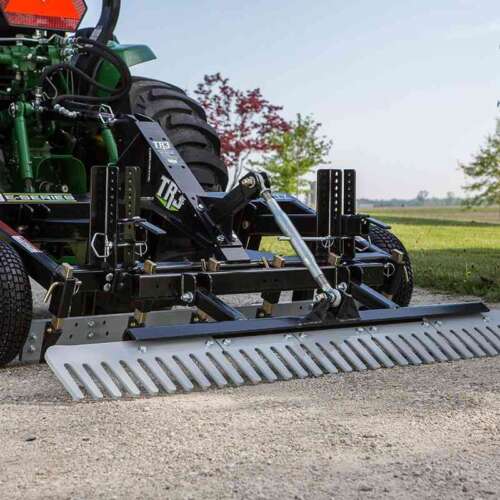
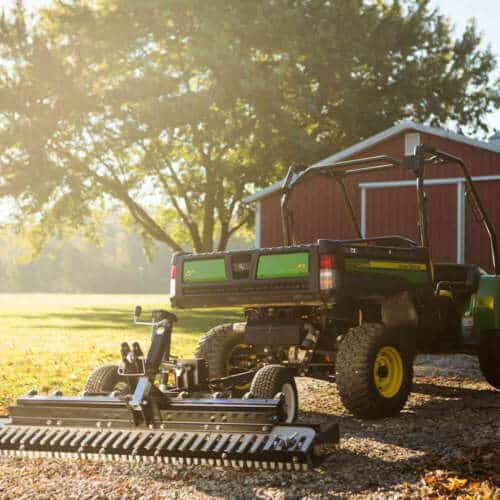
ABI Gravel Rascal Pro
- For ATVs, UTVs, & Sub-Compact Tractors
- 4.5', 5.5', 6.5', & 7.5' Widths
- Starting At: $94/mo.*
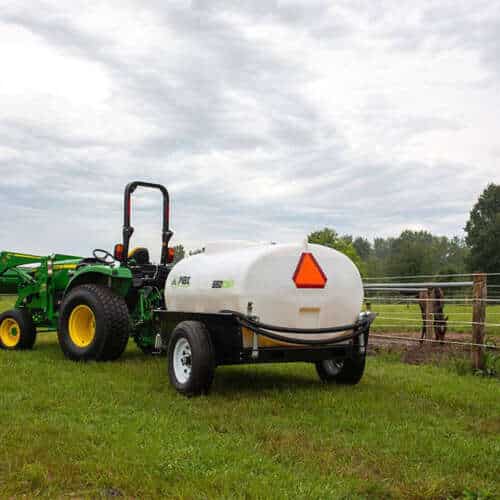
550 Gallon Compact Water Trailer
- Farm Use: Compact Tractor
- Min. Vehicle Weight: 2,400 lbs. On Flat Ground, Towing Capacity 5,200 lbs. On Uneven Terrain
- Starting At: $195/mo.*
Transcript
Food Plot Prep
Hi, everyone. Matt, here with ABI attachments. Welcome back to another episode of the ABI Dirt, as fall rolls around the corner. Many of you, myself included, are looking forward to hunting season. And one of the best ways you can prepare hunting season either right ahead of hunting season, or, you know a couple months prior to hunting season is to establish a healthy food plot. So today, on The Dirt, we are going to talk through just a very, very short overview of the steps required in order to establish a food plot on your property, or on the property of someone who really likes you.
Picking Your Spot for Food Plot
Step number one in establishing a food plot, you’ve gotta pick where you want it to be, right? Remember, the whole point of a food plot is to build a healthy herd or build a healthy gathering of wildlife. So, find a spot on your property or a friend’s property that you want to be hunting on later, and pick where you want that herd to naturally traffic. Now, you can get as specific and detailed or as flippant as you want to. Some of you don’t wanna take a lot of time and energy in this step of the process. Totally fine. Find a spot out of the way, plant a food plot. Check, done, off the list. There is a significant amount of energy and research you can put into this process, though. If you want to test the soil, see what the pH balance is. If you want to see what your soil type is, sand to clay ratio. To what kind of plants grow best into that soil.
You can talk about elevation, you can talk about slope, you can talk about how close or far away from other food sources. So, there’s a lot of energy you can put into this step, but bare bone, step one, pick your spot. Find where you want the food plot.
Food Plot Preparation Equipment
Step two then, is to clear the ground, clear the space, and prepare to plant what you want planted. Most likely, wherever you’ve picked already has some kind of vegetation growing. If you picked a gravel drive that doesn’t have any vegetation, then you may wanna pick again. That’s just my free two cents today. So, whatever’s growing there naturally, you need to get rid of it. You can either spray and mow and clear it out that way. Or you can just dig in, which is why we’re here. You can dig in and chop up the vegetation that’s there, so that you can get down to bare dirt. A lot of different ways to go about this. If you’ve been around ABI attachments for any length of time, you know, we have quite a few videos on how to clear soil to create spoil piles, to get root balls of native vegetation out of your way. So you’ve got healthy, thick, deeply de-compacted soil so that it can take seed for germination.
How to Prep the Ground For Your Food Plot
So, think about what seed you’ve got. Remember that, most likely, whatever you’re planting in a food plot scenario it’s going to require much deeper de-compaction than your average, you know, grass seed for your lawn. Whereas if you’re used to, you know over seeding or reseeding your lawn, two or three inches of de-compaction might be sufficient, but in a food plot you may need to be getting five, six, seven inches deep so that you can have that. What you’re planting in your food plot to be able to get the depth of roots that it needs in order to grow and be healthy. So, this is why getting a deeply de-compacted food plot is why we created the food plot disc, just for you. So if you’ve got a tractor, then you are looking at the tier three, the tier three E series that can accommodate these food plot discs for tractors. If you’ve got an ATV or UTV, we haven’t left you outta the mix. We have got an atv food plot disc compatible for both the arena rascal pro, as well as the gravel rascal pro.
How to Prep Soil for Seeding
So, wherever you’ve decided to plant your food plot, you need to rip out the vegetation. Really rip up what’s there. Get a nice deep rip so that you can put the seed down. One last step in the ground preparation process. If you’re used to using a disc harrow. Now, you know, the standard disc harrow that has two rows of disc alternated angles, then you say, all right, great. I’ve prepared the soil, Matt, I get it. Now I can throw seed down. One last step, though. Ideally, you would make some kind of finishing pass with something specifically designed to finish the soil, smooth the soil so that you can have better seed to soil contact ratio. So that’s why on ABI attachments products, we’ve got that finish rake out the back end, because once the food plot discs go through chop up the vegetation, turn the soil over. You’ve got some big clogs, but you run that finish rake over the top and you break up the clogs.
If you don’t have an ABI attachments product, this is where you then pull out your chain harrow so that you can work up those clods. The benefit of the cultipacker is so that you can put some dimples in the soil somewhere where that seed can fall and you can get some, some great coverage on those seeds.
Seeding Food Plots
And now we get onto the seeding. So if you’ve got your soil finished, it’s time to throw the seed down. If you have in your mind if you’ve never done this before, if you have in your mind you just get to walk the seeder, like you do on your lawn. You can do that, depending on your food plot size. That may be a little bit tiresome. So we’ve got, available for you, if you don’t have one and need one, both a tow behind and a three point broadcast spreader. So you’ve got a big enough hopper. You can mix your seed in, an agitator in the middle of that hopper. If you’ve got a broadcast seeder, and you don’t have kind of an auger in the inside, mixing things up, you’re definitely missing out. That will then broadcast your seed. Now, once the seed has been spread, sure you can just pull away and leave it and say job well done. I’m tired. It’s time to go home. Strongly recommend, though. If you’ve got that cultipacker still sitting off to the side, hook the cultipacker back up, and press the seed into the soil. Again, seed by itself is great. Seed with soil, much better. Press that seed in, so that you can press the seed into the soil. You’ve got the moisture needs, the nutrients it needs and less likely that wind or rain is gonna knock that seed outta the way. Thus, ruining all the hard work you’ve put in so far. Once you’ve pressed the seed in, now it’s time to call it a day, but remember you still need to maintain a food plot.
Watering Your Food Plot
Food plots are very rarely, kind of like gardens in this way, very rarely set it and forget it. Depending on how close you are to water, depending on if your climate or your region is particularly prone to dry spells. You may need to find some way of getting water out to that food plot so that it can grow healthy, so that you can get the size of herd that you want. So remember, a water trailer works fantastically in this scenario. If it’s miles away, you may need a DOT model. Otherwise, a compact might do. But you consider, where is where is the closest water source to your food plot so that you can keep that food plot growing healthily. That’s all I’ve got today, everyone. I hope that was a helpful, while still concise, rundown on the steps involved in establishing a food plot on your property. If you have any questions, remember, that’s why we’re here. We get to talk about food plots and soil management all day long. So give us a call. Our product specialists would love to help answering your questions, and remember, as always, like and subscribe so you don’t miss any future episodes. See you next time.
